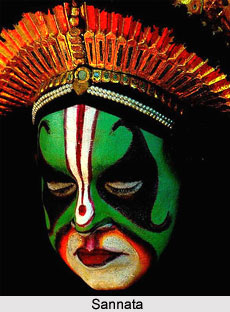 Sannata is an umbrella term for various small-scale Kannada theatre forms of north Karnataka. The adjective refers to the relative scope and the degree of stylization. Previously Sannata was known as Dappu and then it became Dappinata. Dappu is actually a small drum used in performances. In later days Sannata got its present name as a contrastive coinage to Doddata. This is the `large-scale` Bayalata and variant of eastern Yakshagana, whose nomenclature reflected its larger-than-life portrayals. In the second half of the nineteenth century, the arrival of the British and the synthesis of Hindu and Sufi traditions in north Karnataka prompted a cultural shift. As a part of this process, theatre forms began to lean towards popular entertainment. Themes moved towards the worldly and performances became less stylized. This trend crystallized into the Sannata, which became as popular as earlier Bayalata forms like the Dasarata and Radhanata. Sannata is mainly played by non-professional villagers who bring some professional singers and actresses for certain roles from outside.
Sannata is an umbrella term for various small-scale Kannada theatre forms of north Karnataka. The adjective refers to the relative scope and the degree of stylization. Previously Sannata was known as Dappu and then it became Dappinata. Dappu is actually a small drum used in performances. In later days Sannata got its present name as a contrastive coinage to Doddata. This is the `large-scale` Bayalata and variant of eastern Yakshagana, whose nomenclature reflected its larger-than-life portrayals. In the second half of the nineteenth century, the arrival of the British and the synthesis of Hindu and Sufi traditions in north Karnataka prompted a cultural shift. As a part of this process, theatre forms began to lean towards popular entertainment. Themes moved towards the worldly and performances became less stylized. This trend crystallized into the Sannata, which became as popular as earlier Bayalata forms like the Dasarata and Radhanata. Sannata is mainly played by non-professional villagers who bring some professional singers and actresses for certain roles from outside.
It conveniently allows amateurish performance, as the stage is a simple 3-sq.m space, the dance steps minimal, and the costumes of an ordinary kind. A Bhagavata mela called Mummela, helped by his companion Himmela, weaves the episodes. It works the interludes, and keeps providing background support to the performers, thus building up the narrative. Scholars have identified at least three kinds of Sannata plays according to themes used. These are legends of Lord Vishnu, Lord Siva, and contemporary issues. However, in terms of treatment, all varieties show a basic similarity in that archetypal characters that made to appear like normal human beings.
The best example of the most popular Sannata text is Sangya-Balya or "Sangya and Balya". This was based on a real-life incident. It depicts the extramarital relationship between Sangya and Gangi, leading to Sangya`s tragic murder by Gangi`s husband. Banned by the British authorities of the day, the play is now considered a landmark in Kannada drama. On the one hand, it continues to deal with the archetypal themes of forms like the Radhanata, sticking completely too conventional modes of narration. On the other, it suggests the turmoil of its times that introduced new values of money and love, and new institutions or pursuits like the judicial court and non-traditional commerce. The play is remarkably modern in its attitude to this conflict, concluding with an open ending, unlike older works. Later, with many more plays modelled upon Sangya-Balya, Sannata moved towards the idiom of the newly arrived Company Nataka, and the passage from the pre-modern to the modern phase becomes blurred.




















